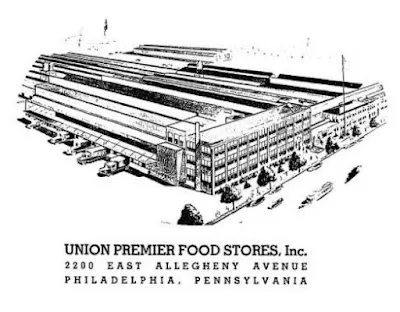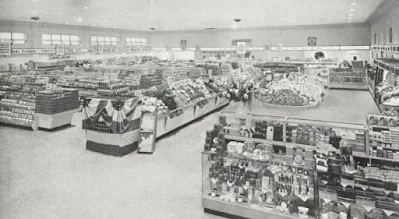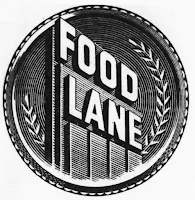Food Store Focus number ten tells the story of the Food Fair chain of Philadelphia, which evolved from a small grocery store in Harrisburg, Pennsylvania. Founded by Samuel and George Friedland, the Reading Great Quality Price Cutter store opened for business in 1920. The first self-service supermarket was dedicated in 1933. In the mid-1930s, the Friedland Brothers moved to a large warehouse and corporate office facility in Philadelphia. They incorporated the business as Union Premier Food Stores.
Drawing from Union Premier Food Stores, Incorporated Annual Report 1939
All newly-built supermarkets operated under a Food Fair nameplate. In 1935, there were nine. By 1937, the count had risen to twenty-two. At this time, all of Union Premier's older, full-service grocery stores were shuttered, with the company focusing entirely on its supermarket business. By the end of 1938, there were thirty-four. Sixty-seven were operating in 1939, covering Maryland, New Jersey and Pennsylvania. Delaware units opened in 1940.
Drawing from Food Fair Stores, Incorporated Annual Report 1942
In 1940, there were seventy-three Food Fair supermarkets. Union Premier Food Stores, and its two Food Fair subsidiaries, were reincorporated as Food Fair Stores. This change became official on April 18, 1942. The full-page spread above shows some of Food Fair Stores' "controlled" (or "house") brand merchandise. Product names include Fyne Taste, Fyne Bake, Fre Mar, Food Fair and Lady Fair.
Graphic from Food Fair Stores, Incorporated Annual Report 1942
In October 1939, two existing chains were acquired; King Arthur Markets {New Jersey} and Giant Stores {Baltimore}. Food Fair Stores was overseeing eighty-nine supermarkets by 1945, with new stores opened in New York State.
Photo from Food Fair Stores, Incorporated Annual Report 1948
An inside view of a mid-century Food Fair supermarket. The company was running 108 stores in 1949.
Photo from Food Fair Stores, Incorporated Annual Report 1948
A customer's order is tallied up in a mid-century store. Observe the check-out girl who -in a pre-Universal Product Code era- must punch the price of every single item into the cash register.
Photo from Food Fair Stores, Incorporated Annual Report 1949
A new decade found Food Fair Stores overseeing 113 supermarkets. In size, these measured between 15,000 and 32,200 square feet. In 1950, the following states were served; Delaware, Florida, Maryland, New Jersey, New York and Pennsylvania.
Photo and graphic from Food Fair Stores, Incorporated Annual Report 1950
The "strands of wheat" trademark was introduced as part of the 30th Anniversary commemoration. Food Fair Stores expanded its realm with the acquisition of Setzer's Supermarkets {Jacksonville}. This deal closed on September 6, 1958. During the 1960s, Best Markets {Philadelphia} was brought under the Food Fair Stores corporate umbrella.
Graphic from Food Fair Properties, Incorporated
Some years before, Food Fair Stores had lost a court battle with the DC-based Square Deal Market Company, who operated a chain of Food Fair stores. These were acquired by the Grand Union Company in January 1955. An agreement with Philly-based Food Fair Stores was struck in October 1958. The DC Food Fair stores would be rebranded with the Grand Union nameplate.
Graphic from the Grand Union Company
During all of the confusion, Philadelphia's Food Fair Stores owned four supermarkets in -and around- the District. These operated under the Food Lane nameplate until being rebranded as Food Fair stores in September 1960.
Graphic from Food Fair Stores, Incorporated
The "Honeycomb" logo made its first appearance in 1963, when Food Fair Stores was managing 551 supermarkets in fourteen states. In addition to those listed above, the company now operated in Connecticut, Georgia, Massachusetts, New Hampshire, North Carolina, Rhode Island and South Carolina.
Graphic from Food Fair Stores, Incorporated
Food Fair stores in Greater New York City were used in ABC-TV's "Supermarket Sweep" game show. After a short quiz, contestants would race through the store, throwing items into a cart. Whoever ended up with the highest dollar amount of merchandise would win. The show's original run was between 1965 and 1967. Since this time, "Supermarket Sweep" has had several revivals.
Photo from Food Fair Stores, Incorporated Annual Report 1965
Graphic from ABC-TV
Three strikingly ultra-modern stores opened in Philadelphia in May 1966. These three units were identical in size and design. In 1966, the Food Fair store count stood at 566.
Photo from Food Fair Stores, Incorporated Annual Report 1965
In a color snapshot, shoppers compare prices in a produce department. The first out-of-country unit opened -in the Bahamas- in 1967. In that year, Food Fair also operated stores in California, Connecticut, Delaware, Florida, Georgia, Maryland, Massachusetts, Nevada, New Hampshire, New Jersey, New York, North Carolina, Pennsylvania, Rhode Island, South Carolina and Virginia.
Photo from Food Fair Stores, Incorporated Annual Report 1968.
Best Markets {Philadelphia} was acquired in the 1960s. One of Best's house brands was Pantry Pride. Food Fair introduced two discount food divisions; Food Fair Quality-Discount and Pantry Pride (this repurposing the old Best's brand name). The first Pantry Pride store opened -in New Jersey- in August 1964. Eventually, the Pantry Pride name was used on newly-built stores. Previous Food Fair units had all been rebranded by 1977. At this time, there were 490 Pantry Pride stores in fourteen states.
Photo from Food Fair Stores, Incorporated Annual Report 1969
In 1976, the company acquired Hills Supermarkets {New York} and Penn Fruit {Philadelphia}. Food Fair took a beating from a troubled national economy. The company went through a Chapter 11 Bankruptcy between October 1978 and July 1981. It re-incorporated as Pantry Pride Stores, with a headquarters in Fort Lauderdale. In 1984, after several divisional sales and store closings, Pantry Pride was operating eighty units in Florida and Georgia. A merger with Revlon, Incorporated was finalized on November 5, 1985. The Pantry Pride name was retired.
Graphic from Food Fair Stores, Incorporated
FOOD FAIR JUNIOR-ANCHORED SHOPPING MALLS:
*CHERRY HILL CENTER, Camden County, NJ (1961)
*DADELAND CENTER / MALL, Dade County, FL (1962)
*TOPANGA PLAZA, Los Angeles, CA (1964)











Dec%201965_ABC-TV_1966.JPG)









